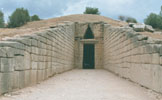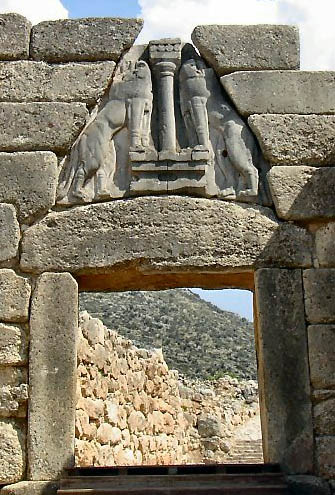1902 Encyclopedia > Mycenae
MYCENAE, one of the most ancient cities of Greece, was situated in the north-eastern extremity of the fertile Argive plain -- mucho Argeos hippobotoio (Gk. ).
Its situation is exceedingly strong, and it commands all the roads leading from Corinth and Achaia into the Argive plain; this fact, combined with its distance from the sea, shows that the city was founded by a race which came from the direction of Corinth and not by immigrants landing on the coast.
The walls of Mycenae are greatest monument that remains of the Heroic age in Greece; part of them is similar in style and doubtless contemporary in date with the walls of the neighbouring town Tiryns, but other parts seem to be the work of a rather later time. There can therefore be little doubt that the two towns were the strongholds, of a single race, Tiryns commanding the sea-coast and Mycenae the inner country.
The city of Argos, on the other hand, has no remains to connect it with this early Mycenaean race; and legend tells of the rivalry between the dynasties of the Pelopidae of Mycenae and of the Protidae at Argos. The long warfare between the two cities lasted till 468 B.C. when Mycenae was dismantled and its inhabitants dispersed. The city never revived; Strabo asserted that no trace of it remained in his time, but Pausanias described the ruins.
Subjoined are the most important monuments:

Sloping passage leading to the doorway of the Treasury of Atreus
1. The "Treasuries" of Atreus and his sons, as Pausanias calls them. They were subterranean buildings of beehive shape, in the side of the hill south-west of the city; one of them is still almost perfect. A sloping passage, dromos (Gk.), led to the doorway with its ornamental columns, at the base of the building. The great circular chamber inside was probably covered with plates of bronze; a door in one side admitted to a second smaller chamber. Such buildings, which are found in other parts of Greece -- e.g., Orchomenus, Spata in Attica, Iolcus, &c. -- were undoubtedly the sepulchres of noble families.
2. The graves discovered by Dr. Schliemann in 1876 within the city wall. They are enclosed within a circular peribolos (Gk.) with a single entrance, and the place was therefore a holy place in the ancient Mycenaean time; on the other hand the part of the city wall which enclosed them is a later addition to the original wall. At some period before 468 B.C. this addition was built; before that time the peribolos (Gk.) was outside the wall. Some heroes of the race were worshipped here by the ancient inhabitants, but their names are not recorded by any trustworthy authority. In the time of Pausanias, six centuries after Mycenae was destroyed, local legend maintained that these were the graves of Atreus, Agamemnon, Cassandra and her children, and Eurymedon; but it is uncertain whether this was the original legend, or a later tale that grew under the influence of Greek literature.

Lion Gate, Mycenae
3. The Lion-Gate. The principal entrance to the city is approached by a dromos, flanked on each side by the city wall and leading up to a gateway. Over the entrance is placed a triangular slab of stone on which are carved two lions in relief; they are rampant, facing one another, but separated by an upright column. The art of this relief shows no resemblance to archaic Greek art; in is foreign in character, the work of immigrant race, which brought with it a well-developed civilization.
Greek legend always maintains that the Pelopidae of Mycenae came from Phyrgia, and this is corroborated by the evidence of archaeology. The objects found in excavations, and the sculptured ornament on the doorways of the "Treasuries" and over the Lion Gate, all point to foreign influence and particularly to Asia Minor . The same type of the two lions and the column has been recently found over the entrance to a colossal sepulchre in the rocks near the south-western corner of the Sangarius valley in Phyrgia. Legend and remains alike show that a rich and powerful dynasty of foreign origin ruled at Mycenae; the only early remains in the Greek world that equal them in interest are the ruins of ancient Troy. It is precisely these two cities which are described in the Homeric poems as the two great cities of the Greek world.
|

